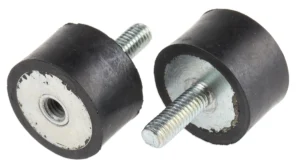Chemical nickel plating of anti-vibration media is a process in which a layer of nickel is applied to the surface of media used to reduce or eliminate vibration in various mechanical systems. This coating offers several advantages, including corrosion resistance, improved durability, and wear resistance. In addition, chemical nickel plating can help maintain the flexibility and elasticity of substrates, ensuring effective vibration absorption. This process is critical to ensuring reliable and safe operation of mechanical systems while reducing the need for frequent replacements and costly maintenance.

How is the use of chemical nickel plating of anti-vibration media adopted?
Nickel plating of anti-vibration mounts is a crucial process that helps improve the performance and durability of these components. Typically, the process begins with preparation of the substrate surface, which may involve cleaning and removal of any contaminants or oxides on the surface. Next, the substrate undergoes a pickling process, which removes any residual corrosion or impurities from the metal surface. This nickel layer provides a protective barrier against corrosion and improves the substrate’s resistance to mechanical stress and vibration. Ultimately, nickel plating of anti-vibration mounts is an important process that helps ensure the stability, reliability and durability of these components, thereby improving the overall performance of the systems in which they are used.
What are the benefits of using chemical nickel plating of anti-vibration media?
The use of chemical nickel plating on anti-vibration media offers several significant benefits:
Chemical nickel plating: Corrosion protection
Nickel plating creates a protective layer on the surface of anti-vibration media, reducing exposure to environmental factors that can cause corrosion, such as moisture, chemicals and oxidation. This extends the life of the media and reduces the need for frequent replacement.
Chemical nickel plating: Improved mechanical strength
The nickel layer adds strength to the structure of the supports, improving their ability to withstand mechanical stress and vibration. This is especially important in contexts where anti-vibration mounts are subjected to heavy loads or intense vibration.
Chemical nickel plating Dimensional stability:
Nickel plating helps maintain the dimensional stability of anti-vibration mounts over time, reducing the risk of deformation or damage caused by environmental changes or mechanical stress.
Chemical nickel plating: Thermal and electrical conductivity
Nickel is a good thermal and electrical conductor, which can be advantageous in applications where good heat dissipation or efficient electrical connection through media is needed.
Chemical nickel plating: Improved aesthetics
The nickel-plated finish gives a more pleasing and professional appearance to the anti-vibration mounts, improving the overall aesthetics of the systems in which they are installed.
In summary, the use of chemical nickel plating on anti-vibration mounts offers a combination of corrosion protection, improved mechanical strength, dimensional stability, thermal and electrical conductivity, and improved aesthetic appearance, thus contributing to improved reliability and performance of systems in which such mounts are used.
In a future how efficient will chemical nickel plating of anti-vibration media be?
In the future, chemical nickel plating of anti-vibration media can be expected to become even more efficient due to continuous technological developments and research in the field of materials and finishing processes. Some possible developments include:
Chemical nickel plating: Advanced materials:
New materials with superior properties could be developed, allowing better adhesion of the nickel coating and greater resistance to corrosion and vibration.
Chemical nickel plating: Improved processes:
New methods and technologies could be introduced to make nickel plating processes more efficient, reducing processing time and associated costs. This could include automating processes and optimizing the chemical solutions used.
Chemical nickel plating: Advanced surface treatments
Innovative surface treatments could be developed to be combined with nickel plating to further improve the corrosion, fatigue and mechanical stress resistance of anti-vibration mounts.
Chemical nickel plating: Sustainable technologies:
With increasing attention to the environment, more environmentally sustainable nickel plating solutions could be developed, using less polluting and more easily recyclable processes and materials.
Chemical nickel plating: Personalization and optimized design:
Nickel plating techniques could be customized to suit the specific needs of anti-vibration mounts, taking into account their sizes, shapes and performance requirements.
In conclusion, chemical nickel plating of anti-vibration media can be expected to become more and more efficient in the future due to technological advances and innovations in materials and processes. This will help to further improve the performance, durability and reliability of anti-vibration mounts, providing greater safety and stability in the systems in which they are used.

